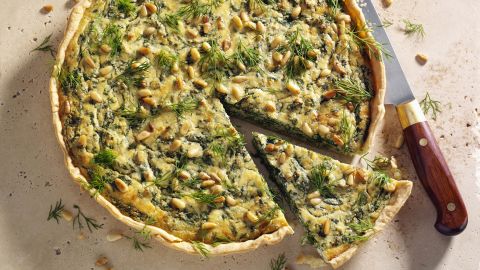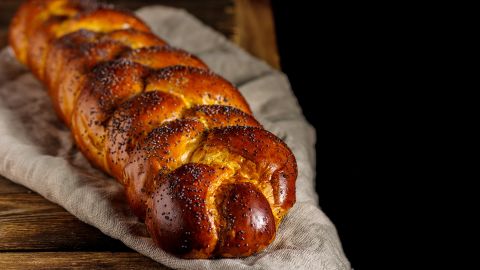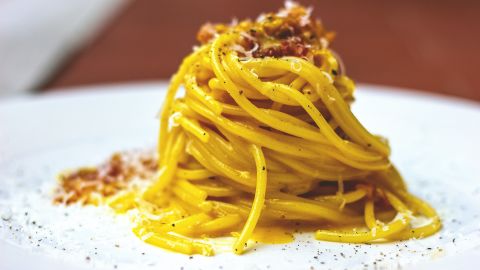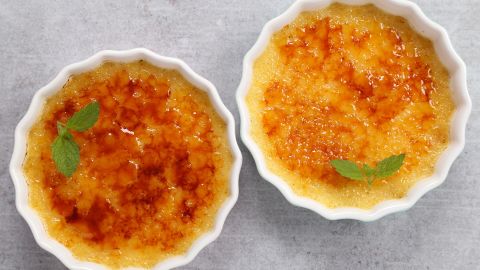Editor’s Note: This month, food writer Casey Barber takes note of great recipes and dishes with eggs. Stay tuned for her May selection, and for all the months that follow.
It’s the most egg-cellent time of the year. Along with crocuses and daffodils, fluffy bunnies and chicks and pastel colors popping up everywhere, spring is the season when the sunny spheres of eggs take center stage.
While you might be getting your fill of the chocolate egg variety this month – I’ll take mine filled with coconut, thanks – April is also the time to celebrate the versatility of fresh eggs.

Eggs are a nutrient-dense food and “a perfect way to jump-start your day,” according to Lisa Steele, fifth-generation chicken keeper, self-described eggs-pert and author of “The Fresh Eggs Daily Cookbook.”
“They fill you up, they have some fat in them, they’re a complete protein, and they’re so versatile,” she said. One egg contains 6 grams of protein and a host of crucial nutrients such as vitamin B12, riboflavin, choline, biotin and selenium.
There’s no need to groan at the thought of using up a baker’s dozen of hard-boiled eggs after Easter for those who celebrate either. In fact, you don’t need to hard-boil eggs before dyeing them. This might not be ideal for anyone hiding eggs for an Easter egg hunt. But for general use, dyed eggs work just as well as au naturel eggs in the following recipes and dishes.
Breakfast all day (and night)
No serious examination of this ingredient’s versatility can begin without an appreciation of the egg breakfast sandwich. Whether it’s on a bagel, crusty roll, English muffin, biscuit or tortilla, a simple scrambled or fried egg is a classic kick-starter for many a morning.
But there’s more to do with an egg beyond the skillet, and it’s OK to take it beyond breakfast, too. Give yourself carte blanche to eat your favorite egg-centric dishes any time of day.
Bake your eggs
For fans of runny yolks, baked eggs in ramekins or muffin tins are much more hands-off than making multiple poached eggs for the family. The basic template is simple: Fill the dish or tin with a combination of meat, vegetables or cheese, then crack in an egg and season with spices and herbs. Bake until the whites are set and the yolks have a bit of jiggle to them.

For those who prefer a more scrambled egg, the savory tart and quiche family is where it’s at – with a bonus of baking them in a flaky edible container. Technically, the difference between a tart and a quiche is a matter of depth: Tarts are baked in shallow pans, while quiches are of the deep-dish variety.
But whichever you choose, a quiche or a tart is an ideal opportunity to make the most of what’s in your fridge. Again, pick a combination of meats, vegetables and cheeses and use an egg custard blended with cream or milk to hold it all together.
Try a chorizo and green chile quiche or a potato, kale and manchego tart to get started.
Egg breads
Love to bake? Now’s the time to try your hand at making an egg-enriched bread. French brioche, Jewish challah, Swiss zopf, Italian pane di pasqua – many cultures have their own version of a sweet, and often braided, bread. Dairy such as milk or butter is also frequently added to these doughs, making them pull-apart tender.

To double your eggy pleasure, slice or cube the bread, and let it sit for a day to go slightly stale. Then turn it into French toast or a decadent bread pudding casserole.
Egg yolks
“I almost feel like the egg yolk and the egg white are two separate foods,” Steele said. With different flavors and textures, the yolk and white can be used separately to add richness and structure to a variety of dishes.
(From a nutritional perspective, the egg white is mostly all protein, while the yolk contains the essential nutrients, so it’s ideal to eat both in some form.)

It’s easier to separate yolks from whites when eggs are cold, and the simplest way is to do it with your hands. Crack the egg into a bowl, then scoop out the yolk and let the excess whites run through your fingers.
For this writer, the most perfect and convenient use of an egg yolk is in spaghetti carbonara. With a ratio of one egg yolk per serving of pasta, it’s an ideal way to make a comforting meal for one or two in a pinch.

Egg yolks are also the base of the intensely rich custard for crème brulée, which can be made in the oven or in a slow cooker. “It’s so fancy, but it’s so easy,” Steele said, and “you can make it in advance if you have people over.”
Egg whites
Once you’ve slurped down carbonara and spooned up crème brulée for dessert, you’ll have a few leftover egg whites. Leave the virtuous egg white omelets for another day and make something a bit more exciting.
The protein-and-water structure of an egg white is what makes it whip into a light and fluffy froth, so use that science to your advantage and make homemade marshmallow spread with just egg whites, sugar and cream of tartar. Or bake angel food cupcakes – you can double your fun and top them with dyed marshmallow spread as frosting if you have a lot of egg whites on hand.
“You can freeze egg whites or put them in the refrigerator if you’re going to use them in a day or so,” Steele said. My strategy for leftover egg whites is to freeze them individually in ice cube trays until needed, so I’ll always have the exact amount called for in a recipe.
Casey Barber is a food writer, illustrator and photographer; the author of “Pierogi Love: New Takes on an Old-World Comfort Food” and “Classic Snacks Made From Scratch: 70 Homemade Versions of Your Favorite Brand-Name Treats”; and editor of the website Good. Food. Stories.
Source: www.cnn.com
